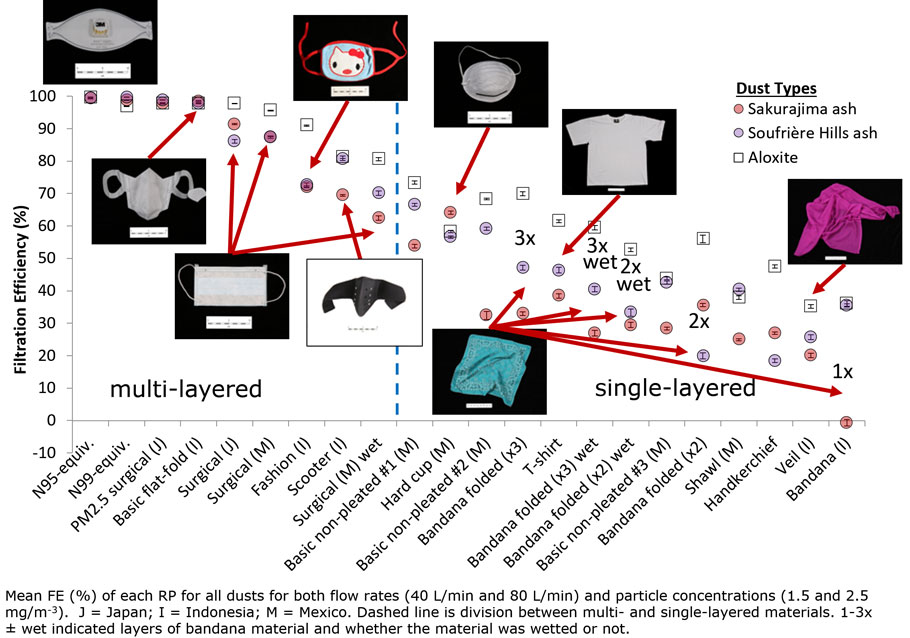To test the effectiveness of different types of respiratory protection at filtering volcanic ash, laboratory tests of filtration efficiency (FE) and ‘total inward leakage’ (TIL) (a measure of mask filtration and fit, on volunteers) were conducted at the Institute of Occupational Medicine, Edinburgh, UK. Seventeen different types of protective materials were sourced from communities living near volcanoes, ranging from industry-certified (N95/N99-equivalent masks – FFP2/3) to hijabs, shawls and bandanas.
The most effective facemasks for filtering ash, and for fit, were shown to be N95/N99-style masks [2, 3] (Figures 1 & 2). Surgical masks, often provided by responders [4], had good filtration but did not seal well to the face [2, 3] although adding an extra layer of cloth (a bandage, in this study), tied around the head on top of the mask to better secure it to the face, did reduce the leakage. Many cloth materials provided little to no protection [2].
The laboratory studies also showed that folding cloth into several layers increased filtration (but not to the level of a surgical mask) but that wetting cloth/masks did not help with filtration [2] (Figure 1).
The laboratory volunteers, and local volunteers who tested mask wearability, near Sinabung volcano, Indonesia, agreed that N95-equivalent masks were not very comfortable to wear [3, 5]. Poorly-fitting (and, hence, less effective) masks were considered more comfortable but the addition of a piece of cloth, to help with facial seal, was not comfortable. There is, therefore, a balance to be struck between the effectiveness and comfort of facemasks.

Figure 1. Results from FE tests showing that industry-certified masks offer almost 100% FE whereas single-layered cloth offers much less filtration. The amount of filtration also depends on the types of particle: Sakurajima and Soufrière Hills are different samples of volcanic ash; Aloxite is a non-toxic analogue dust also used later in the TIL volunteer trials.
| Mask Type | Mask Type | Features | Leakage | Filtration | Notes |
 |
Industry-certified (N95/FFP2) | Nose clip, elasticated head- straps, foam/rubber edge seal | < 10 % | > 99% | Not very comfortable |
 |
‘Flat-fold’ (‘3D’) mask (Japan) | No way of adjusting fit and not clear which orientation it should be worn | 35% | > 98% | Very comfortable but ‘flimsy’ |
 |
PM2.5 surgical mask (Japan) | Cheek and chin ‘flaps’ which fold out. Nose clip, stretchy ear loops | 22% | 98% | Quite comfortable |
 |
Surgical mask | Nose clips, stretchy ear loops | 35% | ~ 90% | Quite comfortable |
 |
Surgical mask + bandage | Closes gaps around the face | 24% | ~90% + ? | Not comfortable |
Figure 2. Summary table of filtration efficiency (see figure, above) and Total Inward Leakage. The most efficient mask had the lowest leakage.

